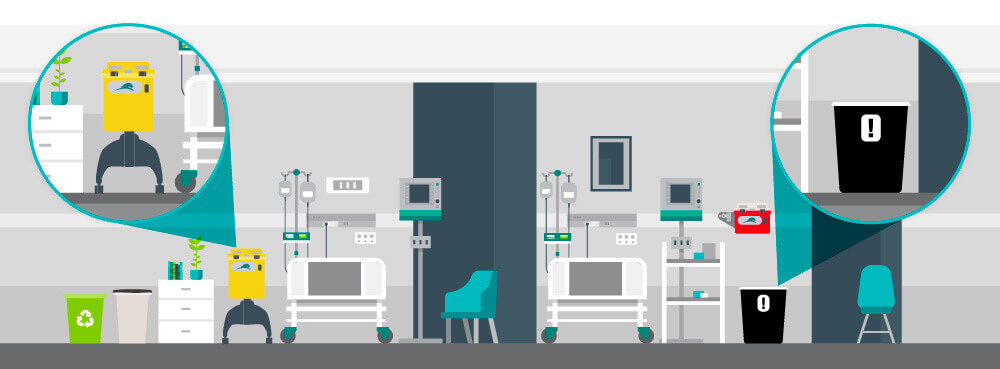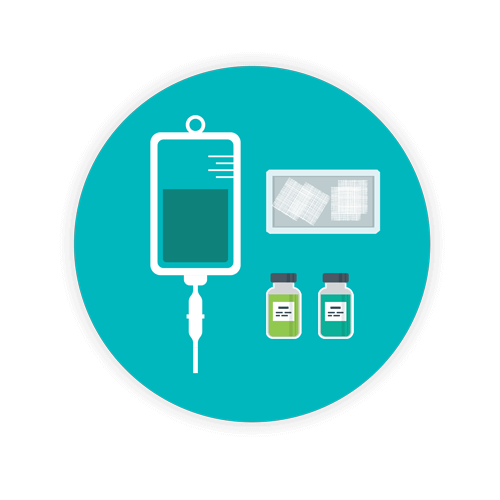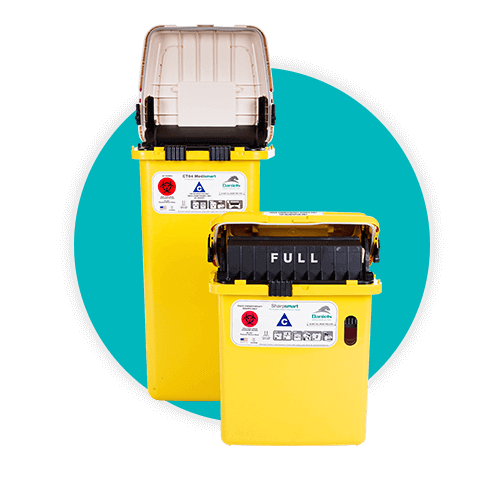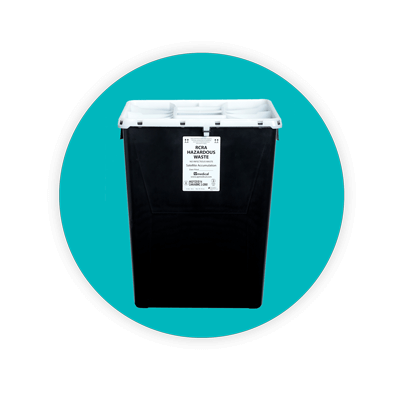How to Dispose of Chemotherapy Waste

Disposing of chemotherapy waste requires a number of considerations. First comes the definition of chemotherapy waste. Is it just the drug? The bag filled with the chemo drugs? The IV tubing? Chemo waste is defined as either trace waste or bulk waste. Which defines the two?
A thorough understanding of terminology goes a long way toward maintaining compliance when it comes to chemotherapy waste disposal because there’s not just one waste stream – there’s two! And it’s up to the waste generator to understand how to segregate effectively between Trace Chemotherapy waste (yellow container) and Bulk Chemo RCRA hazardous waste (black container)
TOPICS WE WILL COVER:
1 / Know the Terminology Around Chemotherapy Waste Disposal
2 / State Guidelines Are More Stringent than Federal Guidelines
3 / What are Hazardous Waste Chemotherapy Drugs?
4 / Segregating Chemotherapy Waste
5/ Understanding Trace vs. Bulk Chemotherapy Waste
6/ Bulk Chemotherapy Waste/ RCRA
7/ Daniels is the Industry Leader for Chemotherapy Waste
Know the Terminology Around Chemotherapy Waste Disposal

It’s not just the drugs or medications used for chemotherapy delivery that are of concern when it comes to collection, segregation, and disposal. What do you do with the tubing, the needles, and the packaging the chemo drugs came in? Is chemotherapy waste classified as hazardous waste or medical waste? Let’s start with the industry definitions and then we’ll walk you through how to segregate chemotherapy waste effectively in your facility.
When it comes to chemotherapy treatments, chemotherapy or trace chemotherapy waste is produced during the preparation of or administration of chemotherapy, but not all waste comes into contact with the actual chemotherapy drug. So how are these items segregated?
Trace chemotherapy waste can include IV tubing, medicine bags, vials, or any part of the tubing and needle system that delivers the chemotherapy drug to a patient. However, personal protective equipment (PPE), towels, wipes, and pads may come into contact with chemotherapy drugs as well, and proper disposal is mandatory. Chemotherapy wastes are defined as a hazardous waste by the EPA and are treated as medical waste through incineration.
At its simplest definition, chemotherapy drugs that are listed as hazardous waste chemotherapy drugs must be segregated, managed, and transported as hazardous waste rather than “just” medical waste.
However, if the container is deemed “RCRA empty” – meaning only trace amounts (less than 3% residual) of the chemotherapy drug are found on waste items such as draping or gloves and tubing – these items can be disposed of in a “non-hazardous” yellow trace chemotherapy container.
Terminology is important in chemotherapy waste segregation processes, as terminology has changed over the years. Today, trace chemotherapy waste is termed “RCRA empty” if, after the contents of the bag have been emptied through various methods (infusion, pouring, or pumping), the container or bag holds less than 3% total volume. At that point, it’s deemed “empty,” and is therefore exempt from hazardous waste regulations. Such regulations have been around for a while, per the EPAs Introduction to Containers training document (40 CFR Parts; §261.7).
State Guidelines Often More Stringent than Fedeal Guidelines
Every state has its own guidelines for disposal of chemo waste, but all regulations (federal, state, and local) must be followed. For example, New Hampshire’s management and disposal guidelines for U-listed antineoplastic (chemo) wastes provides explicit instructions on how chemotherapy waste is to be dealt with, in addition to following federal standards.
Because states throughout the country employ different standards when it comes to the handling and disposal of chemotherapy waste, it is best to become familiar with regulations of their locality and state, plus federal guidelines forward and backward. Some states mandate that all chemo waste be handled as a hazardous waste product and such waste must be segregated from other types of waste. Others differ in both wording and requirements.
What are Hazardous Waste Chemotherapy Drugs?
Wastes can be hazardous waste because of their characteristics (ignitability, corrosivity, reactivity and toxicity) or because they are specifically listed as hazardous waste. Nine chemotherapy drugs are listed or characteristic hazardous waste and each are assigned an EPA (U.s. Environmental Protection Agency) waste code. These include:
- Arsenic Trioxide
- Chlorambucil
- Cyclophosphamide
- Daunomycin
- Diethystilbestrol
- Melphalan
- Mitomycin C
- Streptozotocin
- Uracil Mustard
Segregating Chemotherapy Waste
Special containers designed for chemotherapy waste can help the segregation process. For example: sharps used in chemotherapy administration. In such situations, not all sharps containers are meant to contain all sharps waste. Daniels Health makes it easier to segregate chemo waste from other waste streams with single use or reusable chemotherapy collectors and sharps containers in a variety of sizes. Some are designed for small quantity generators and small spaces. Some are disposable and others reusable. When it comes to different colored containers and tops to identify different waste streams. Our Chemosmart container comes with a yellow top and body to clearly identify it as a trace chemotherapy waste container and can be situated in a patient’s room, infusion bay or the chemotherapy treatment center. HOWEVER this is for Trace Chemotherapy waste… let’s dive into trace vs bulk.
When it comes to different colored containers and tops to identify different waste streams. Our Chemosmart container comes with a yellow top and body to clearly identify it as a trace chemotherapy waste container and can be situated in a patient’s room, infusion bay or the chemotherapy treatment center. HOWEVER this is for Trace Chemotherapy waste… let’s dive into trace vs bulk.
Understanding Trace vs. Bulk Chemotherapy Waste
If a chemo drug waste is classified as a HWP (Hazardous Waste Permitting) by RCRA, and more than 3% of the residual drug remains, it is referred to as “bulk chemo waste” and must be managed as hazardous waste (not chemotherapy waste) and disposed in a black RCRA container. However, if the container (or waste item) is deemed “RCRA-empty” (only residual remaining) or there are only trace amounts of the chemotherapy or antineoplastic agent remaining on the items of waste, this is classified as “trace chemo waste”. Items used in the administration of chemotherapy and antineoplastic agents that could be contaminated with trace or bulk amounts of chemotherapy drugs include:
Bulk Chemotherapy Waste/ RCRA
A container filled with trace amounts of RCRA ‘empties’ and byproducts must be contained in separate containers with clearly marked labels for “incineration only” or “chemotherapy waste” based on state requirements. Every state facility needs to verify the process for removal of such containers from their property, even with their medical waste company.
Bulk chemo waste must be in a RCRA rated container; black containers are the industry standard but ultimately the color doesn’t matter. Bulk chemotherapy waste is defined as any chemotherapy waste that is not deemed RCRA-empty. This can include but is not limited to half-empty IV bags, vials, or syringes. Any items used to clean up a chemo spill are also deemed as bulk chemo waste. Such waste must be stored in containers approved by the Department of Transportation (DOT) when it comes to transportation of hazardous materials and correctly labeled as a hazardous pharmaceutical waste, and per very specific DOT hazard classifications.
The medical waste business responsible for transporting that waste must also hold permits from the EPA for the proper management and disposal or treatment of that waste. Most states and localities also have mandatory regulatory guidelines for companies transporting and disposing of hazardous pharmaceutical waste and bulk chemo waste.
It is the responsibility of the generator to make sure that the medical waste disposal or medical waste pickup companies used by the facility are following regulatory guidelines. If they’re not, you also may bear the brunt of penalties and fines associated with noncompliance. It’s not just an ethical scenario, it’s the law.
As mentioned earlier, different states have varying guidelines on how to manage, handle, segregate, and transport chemotherapy waste. For example, Florida follows the guidelines of the RCRA regulations when it comes to handling of hazardous waste (Title 40 CFR parts 260 through 271). The state of Florida also has its regulations, found in Florida’s Administrative Code, Rule 62 through 730.
In California, the department recommends that non-RCRA hazardous waste be segregated and managed from RCRA hazardous waste, and that only pharmaceutical waste that falls under California’s Title 42 §6901 should be disposed of in hazardous waste containers, including bulk chemotherapy drugs.
Can I dispose of Trace Chemotherapy and Bulk Chemotherapy Waste in the same container?
Yes you can, however in this case it would all need to be “overcategorized” into a black hazardous waste bin. You cannot dispose of bulk chemotherapy waste (i.e. more than 3% of the residual drug) in a yellow chemotherapy waste container. Overcategorizing waste into a single black RCRA container for incineration will save time segregating the waste into two waste streams, however it will have a few negative side-effects, these include:
- A significant increase in costs. RCRA hazardous waste is at minimum three times the disposal cost of Trace Chemotherapy Waste
- Negative Environmental Impact. All RCRA hazarous waste containers are disposable and incinerated, increasing plastic and environmental burden
- Reduced safety and staff protection. RCRA hazardous containers are not designed for a patient environment with safety, security or overfill mechanisms
 Daniels Health is the Industry Leader in Chemotherapy Waste Collection.
Daniels Health is the Industry Leader in Chemotherapy Waste Collection.
Is it a black container? Is it a yellow container? We understand that it can be confusing, particularly when patient care is the number one priority and waste is just a by-product of a procedure. At Daniels Health, we try to simplify. Through education, clearly differentiated containers, right-fit placement for optimal use and partnership – we create a bespoke chemotherapy waste program that balances requirements for not only Trace Chemotherapy and RCRA waste, but also the integration of the new USP800 standards using our Chemosmart containers.
At Daniels, we focus on a fully integrated healthcare waste management program – delivering standardization across containers used, waste-stream education, segregation and waste pickup schedules. Through a full consolidation of all waste streams managed by a single partner, we ensure that your costs are optimized, patient interruptions are minimized and through every aspect of our service from waste collection in hospitals or oncology centers to transport and final disposal, we provide the highest standards of safety and sustainability. If you are interested to talk to one of our chemotherapy waste specialists to see how we can transform your chemotherapy waste program, click here.
Let's Talk!
Your time is valuable, and we don’t want to play hard to get. You can either phone us directly on the details listed on our contact page, or feel free to fill out this short form and one of our team members will get back to you as quickly as possible.
